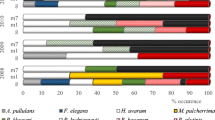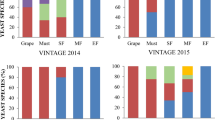Abstract
Fresh and cooked agave,Drosophila spp., processing equipment, agave molasses, agave extract, and fermenting must at a traditional tequila distillery (Herradura, Amatitan, Jalisco, México) were studied to gain insight on the origin of yeasts involved in a natural tequila fermentations. Five yeast communities were identified. (1) Fresh agave contained a diverse mycobiota dominated byClavispora lusitaniae and an endemic species,Metschnikowia agaveae. (2)Drosophila spp. from around or inside the distillery yielded typical fruit yeasts, in particularHanseniaspora spp.,Pichia kluyveri, andCandida krusei. (3)Schizosaccharomyces pombe prevailed in molasses. (4) Cooked agave and extract had a considerable diversity of species, but includedSaccharomyces cerevisiae. (5) Fermenting juice underwent a gradual reduction in yeast heterogeneity.Torulaspora delbrueckii, Kluyveromyces marxianus, andHanseniaspora spp. progressively ceded the way toS. cerevisiae, Zygosaccharomyces bailii, Candida milleri, andBrettanomyces spp. With the exception ofPichia membranaefaciens, which was shared by all communities, little overlap existed. That separation was even more manifest when species were divided into distinguishable biotypes based on morphology or physiology. It is concluded that crushing equipment and must holding tanks are the main source of significant inoculum for the fermentation process.Drosophila species appear to serve as internal vectors. Proximity to fruit trees probably contributes to maintaining a substantialDrosophila community, but the yeasts found in the distillery exhibit very little similarity to those found in adjacent vegetation. Interactions involving killer toxins had no apparent direct effects on the yeast community structure.
Similar content being viewed by others

References
Buchanan RE & Gibbons NE, Eds (1974) Bergey's manual of Determinative Bacteriology. 8th Edition, Williams & Wilkins, Baltimore
Lachance MA (1987) Approaches to yeast identification. In: Berry DR, Russell I & Stewart GG (Eds) Yeast Biotechnology (pp 33–51) Allen & Unwin, London
—— (1993)Metschnikowia agaveae sp. nov., a heterothallic haploid yeast from blue agave. Can. J. Microbiol. 39: 562–566
Nobel PS (1994) Remarkable agaves and cacti. Oxford University Press, New York (166 pp)
Sánchez-Marroquín A & Hope PH (1953) Agave Juice. Fermentation and chemical composition studies of some species. J. Agric. Food Chem. 1: 246–249
Subden RE (1990) Wine yeast: selection and modification. In: Panchal CJ (Ed.) Yeast Strain Selection (pp 113–137) Marcel Dekker Inc., New York
van der Walt JP & Yarrow D (1984) Methods for the isolation, maintenance, classification and identification of yeasts. (pp 45–104) In: Kreger-van Rij NWJ (Ed.) The Yeasts, a Taxonomic Study, Elsevier, Amsterdam
Woods DR & Bevan EA (1968) Studies on the nature of the killer factor produced bySaccharomyces cerevisiae. J. Gen. Microbiol. 51: 115–126
Young TW (1987) Killer Yeasts. (pp. 131–164) In: Rose AH & Harrison JS (Eds) The Yeasts, Volume 2. Yeasts and the Environment. Academic Press, London
Author information
Authors and Affiliations
Rights and permissions
About this article
Cite this article
Lachance, MA. Yeast communities in a natural tequila fermentation. Antonie van Leeuwenhoek 68, 151–160 (1995). https://doi.org/10.1007/BF00873100
Issue Date:
DOI: https://doi.org/10.1007/BF00873100



